Important PUL Collections
A snapshot in time
The vascular plant specimens of the PUL represent an opportunity to reconstruct the original flora of Indiana, in addition to the wider Midwestern and Great Lakes regions of the United States in general. Few endemic populations remain in these areas due to agricultural development, and the PUL serves to provide representative collections of these native species. The PUL's namesake, Ralph M. Kriebel, was especially interested in ferns and oaks, and as a result, there are important Indiana collections of these plants available from areas where they can no longer be found. A further case in point, in 1916 Charles C. Deam (below) collected a specimen of the evergreen shrub Chamaedaphne calyculata, or leatherleaf, from a bog in DeKalb County, Indiana. This collection is now the only indication of the original natural ecology of this site, as the area has since been destroyed by peat mining.
Charles C. Deam
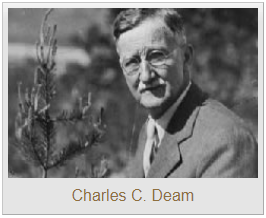
Charles C. Deam (1865–1953) was an Indiana drugstore owner and self-taught botanist, appointed the first Secretary of the State Board of Forestry in 1909, first State Forester in 1917, and head of the Forestry Division of the Department of Conservation in 1919. He became widely known for many publications on Indiana plants, culminating in his 1940 work Flora of Indiana. He walked through all 1016 townships in Indiana, discovered 25 new plants and has 48 named for him. Deam particularly focused on ferns and oaks (the latter, genus Quercus), two passions that he would pass on to Ralph M. Kriebel, who began his own herbarium in 1932 after receiving encouragement from Deam.
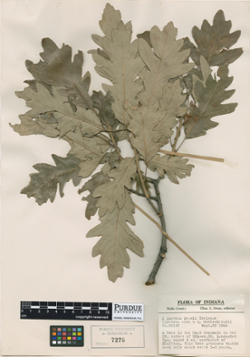
and twigs. Full image.
In October 1904, Deam forwarded a specimen from a peculiar oak tree in Wells County, Indiana to William Trelease at the Missouri Botanical Garden for identification, believing it to be a hybrid of nearby Quercus species. Deam remained vigilant of this tree, and in 1915 he was notified that it had been marked for removal by the landowner. To save the unique tree, Deam bought the 0.2-acre plot surrounding it for the exorbitant sum of $75. He deeded the land to the State, and it has since been the Deam Oak Monument Forest, the smallest preserve in Indiana. In 1916 Deam sent seeds of his saved oak to the Arnold Arboretum of Harvard University that still maintains two individuals of the hybrid, which was named Quercus X deamii by Trelease in 1917.
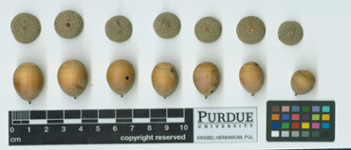
Deam collected PUL specimen 7275 of Quercus X deamii from the Forest at the age of 79. Robert C. Kriebel, son of Ralph M. Kriebel for whom the PUL is named, describes the location in his 1987 biography, Plain Ol' Charlie Deam, Pioneer Hoosier Botanist: "Northwest of Bluffton, off Indiana 116 at County Road 250-N, the traveler encounters [the] hundred-foot-square reservation. And forty feet from the highway pavement, the Deam oak lives on, plain and battered as its namesake."
George Armstrong Custer
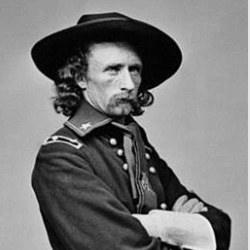

The PUL contains a dozen specimens believed to have been collected by botanist Aris Donaldson while in the company of Lt. Col. George Armstrong Custer (Shaner and Harby 2012). Custer was the leader of the U.S. Army's 7th Cavalry, notorious for the 1876 Battle of the Little Bighorn (or Battle of the Greasy Grass), an act of aggression against the Lakota Souix, Dakota, Northern Cheyenne, and Arapaho indigenous people.
In 1874, Custer led his forces into the Black Hills of what is now western South Dakota and eastern Wyoming. On July 25, the expeditionary force entered what Custer called the Floral Valley. In a dispatch Custer wrote: "Its equal I have never seen. Every step of our march that day was amid flowers of the most exquisite colors and perfume. So luxuriant in growth were they that the men plucked them without dismounting from the saddle. It was a strange sight to glance back at the advancing columns of cavalry, and behold the men with beautiful bouquets in their hands, while the head-gear of the horses were decorated with wreaths of flowers fit to crown a queen of May."
Eli Lilly & Company Collection
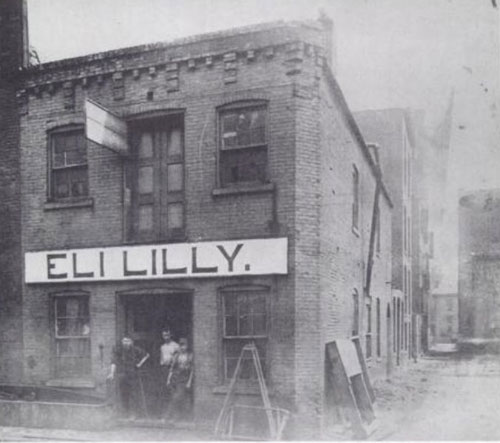
In 2012, the PUL acquired over 14,700 specimens from Eli Lilly & Company Pharmaceuticals, Indianapolis, Indiana. The company was founded in 1876 by Colonel Eli Lilly. A total of 397 type specimens of vascular plants were databased and imaged in 2012 as part of the Global Plants Initiative. The majority of these Isotype specimens are from the collection of Cyrus G. Pringle (1838–1911), noted in the top five historical American botanists for the quantity of new species discovered (approximately 1,200 species and 29 genera). In 2014, the U.S. Institute of Museum and Library Services, via the Indiana State Library, awarded the PUL funds to catalog and digitize the Lilly collection to be incorporated into the Indiana Memory project.
Type Collections
A type specimen is a specimen, or set of specimens, on which a botanist or mycologist based their description of a new species. These specimens are crucial to the science of biological taxonomy and biology as a whole and these type collections are considered the lynchpin of biological research. As of 2014 roughly a quarter of the estimated 90,000 specimens in the PUL have been cataloged. Of these, 700 type specimens have been identified. Over half of these are from the Eli Lilly & Co. donation (above). An additional dozen have been identified from the vascular plants and bryophytes collection and close to 300 fungal specimens are noted as being types. These numbers are sure to grow as we continue to explore and catalog the remainder of the collection.
Alton Lindsey
Alton Lindsey was a professor of forest ecology at Purdue University from 1947–1973. He had previously served as the vertebrate biologist on the 1933–35 Antarctic expedition by polar explorer Admiral Richard Byrd and brought with him specimens from his previous works. In addition to plants he collected during his arctic journey, the PUL has assessioned over 1,000 specimens from Lindsey, many collected from the Ross Biological Reserve in Tippecanoe County, Indiana. Lindsey was instrumental in establishing the reserve and was so influential throughout his field that fellowships, laboratories, an insect, and a collection of 12 islands off the coast of Antarctica, have been named after him.
Fungal Exsiccati
The companion herbarium, the Arthur Fungarium (PUR), contains one of the world's largest collections of plant rust fungi (Pucciniales). J.C. Arthur stipulated that the holdings of the Arthur Fungarium be restricted in perpetuity to the rust fungi, so specimens of all other fungal organisms are maintained in the PUL. Among these are several very important collections known as "exsiccati" from around the world. Exsiccati are sets of dried specimens sent in exchange or for sale by experts. These collections represent very valuable reference material to the species concepts of these experts and to the species present in a variety of geographic areas across the globe.
Additional Collections
Other published botanists who contributed to the PUL include:
-
- Alida Cunnigham who contributed to the Distribution of Orchidaceae in Indiana (Brunson, 1942)
- Winona Welch, author of Mosses of Indiana (Welch, 1957), born in Jasper County, and established the DePauw University Herbarium
- W. B. Van Gorder who authored the Catalog of the Flora of Noble County, Indiana (Van Gorder, 1885)
- Purdue University alumna Sally Weeks, author of Native Trees of the Midwest (Weeks, 2010)
Indiana amateur botanists of note also include:
-
- B. H. Doddridge, County Agent from Jefferson County
- Herman B. Dorner, Lafayette's "great carnation florist"
- Scott McCoy, Director of Halleday Park Botanical Garden in Indianapolis and Chairman of the Meeting of Plant Taxonomists in Indiana along with Charles C. Deam and Ralph M. Kriebel (Anon 1943)
Beyond Indiana, the PUL contains collections made by other important early American botanists. One of these is Mary Agnes Chase, an American botanist who worked at the U.S. Department of Agriculture and the Smithsonian Institution. Considered one of the world's outstanding grass researchers, she is also widely known for her activism in establishing women's voting rights in the United States.
Anon, 1943. Meeting of Plant Taxonomists. Proceedings of Indiana Academy of Science.
Brunson ME. 1942. Distribution of Indiana Orchidaceae. Butler University Botanical Studies 5: 173–178. Link here.
Deam CC. 1940. Flora of Indiana. Indianapolis: Department of Conservation, Division of Forestry, Indiana. 1236 pp.
Hibben G. 2012. Charlie Deam and the Deam Oak (Quercus X deamii). Arnoldia 67: 15–24.
Kriebel, RC. 1987. Plain Ol' Charlie Deam: Pioneer Hoosier Botanist. Purdue University Press, West Lafayette, Indiana. 208 pp.
Porter CL, Porter JN, 1930. The Stanley Coulter Herbarium at Purdue University. Proceedings of Indiana Academy of Science 40: 115–118. Link here.
Webster GL. 1961. The Kriebel Herbarium at Purdue University. Proceedings of Indiana Academy of Science 71: 233–234. Link here.
Weeks SS, Weeks Jr. HP, Parker GR. 2010. Native Trees of the Midwest: Identification, Wildlife Values, and Landscaping Use. Purdue University Press, West Lafayette, Indiana. 368 pp.
Welch WH. 1957. Identification of Mosses of Indiana: an illustrated manual. Indianapolis: Department of Conservation, Division of Forestry, Indiana. 478 pp.
Van Gorder WB. 1885. Catalogue of the Flora of Noble County, Indiana.
